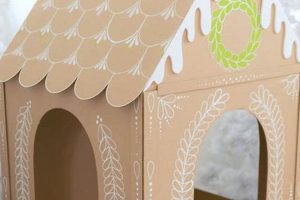A seating structure created through individual effort using concrete blocks as a primary component. The construction typically involves arranging concrete blocks to form a base, often paired with a wooden or composite material for the seating surface. Assembled without specialized tools or advanced construction skills, these structures represent a simplified approach to outdoor furniture creation.
The appeal of this construction method lies in its affordability, accessibility, and modularity. The low cost of concrete blocks, coupled with the ease of assembly, renders it a practical option for budget-conscious individuals or those seeking easily customizable outdoor seating. Furthermore, the materials’ inherent durability allows for placement in various outdoor environments. This method echoes a long history of utilizing readily available, sturdy materials for functional purposes.
The subsequent sections will detail material selection, step-by-step assembly instructions, design considerations, safety precautions, and potential modifications for enhanced aesthetics and functionality. These elements provide a complete guide for constructing durable and visually appealing outdoor seating.
Construction Tips for Concrete Block Seating
The following guidelines are intended to optimize the structural integrity and aesthetic appeal of seating assembled with concrete blocks.
Tip 1: Surface Preparation. Ensure the ground surface is level and compacted before commencing construction. An uneven base compromises stability and longevity. Consider using a leveling compound or compacting gravel to achieve a stable foundation.
Tip 2: Block Alignment. Precisely align the concrete blocks to ensure a uniform appearance and even weight distribution. A spirit level is essential for accurate horizontal alignment, preventing structural weaknesses.
Tip 3: Securing the Seat. Implement a secure method for attaching the seating surface to the concrete blocks. Construction adhesive or mechanical fasteners, chosen based on the materials’ compatibility, should be employed to prevent slippage or dislodgement.
Tip 4: Material Selection. Select weather-resistant materials for the seating surface. Untreated wood is susceptible to rot and degradation. Composite decking or treated lumber offers increased durability and longevity in outdoor environments.
Tip 5: Weight Distribution. Consider the intended load capacity when designing the seating structure. Distribute weight evenly across the concrete blocks to prevent stress concentrations that could lead to cracking or instability.
Tip 6: Consider Adding Support.For longer benches, consider adding center support under the seating surface to prevent sagging. An additional row of concrete blocks, or a strategically placed wooden support, can significantly improve the bench’s load-bearing capacity.
Tip 7: Protect the Blocks. Consider sealing the concrete blocks with a masonry sealer. This will protect them from water damage, staining, and deterioration over time, prolonging the life of the bench.
Adherence to these guidelines will result in a seating structure that is both functional and aesthetically pleasing, demonstrating structural soundness and longevity.
The final section will discuss modifications and aesthetic enhancements to customize the seating structure to individual preferences and environmental contexts.
1. Stability
Stability constitutes a fundamental requirement in the construction of seating structures utilizing concrete blocks. The structural integrity of such a bench directly correlates with its ability to withstand applied loads without deformation or collapse. A lack of stability poses safety risks and undermines the functionality of the seating.
- Foundation Integrity
The nature of the underlying surface is paramount to stability. An unlevel or insufficiently compacted base will cause uneven weight distribution, leading to potential tipping or structural failure. Preparing a solid, level foundation, possibly with compacted gravel or a leveling compound, is crucial for ensuring a stable base. This is exemplified by benches placed on uneven ground displaying a noticeable wobble or leaning posture.
- Block Alignment and Interlock
Precise alignment of the concrete blocks is necessary for distributing the load evenly across the structure. Misalignment creates stress points and compromises the overall strength. Interlocking blocks, where possible, enhance stability by preventing lateral movement. An example is a bench where poorly aligned blocks result in visible gaps or a lack of uniform support.
- Securing the Seating Surface
The method of attaching the seating surface to the concrete block base significantly impacts stability. A secure connection, achieved through construction adhesive or mechanical fasteners, prevents the surface from shifting or dislodging under load. A weakly attached surface results in instability and potential hazard as the surface could come off during usage.
- Weight Distribution Considerations
The bench’s design must account for the anticipated load. Even distribution of weight across the blocks prevents stress concentrations. Reinforcement of the seating surface, particularly for longer benches, can further enhance stability by preventing sagging. An example is a bench designed with insufficient support along its length that exhibits noticeable bending under weight.
These facets of stability are inextricably linked in the construction of seating using concrete blocks. Addressing each aspect contributes to a seating structure that is safe, durable, and capable of withstanding the intended use. Ignoring any single facet increases the risk of structural failure, thereby negating the advantages of a cost-effective and accessible construction method.
2. Durability
Durability, the capacity to withstand wear, pressure, or damage, is a critical factor in evaluating the suitability of concrete blocks for seating. The longevity and overall value proposition of a bench constructed from these materials are directly contingent upon its ability to resist environmental degradation and physical stress.
- Material Composition and Resistance
The inherent composition of concrete imparts a degree of resistance to weathering, insect infestation, and rot, phenomena that frequently compromise the lifespan of other outdoor materials like untreated wood. For instance, a concrete block bench subjected to prolonged exposure to rain and sunlight will exhibit significantly less degradation compared to an equivalent structure made from non-pressure-treated lumber. However, porosity can lead to cracking in freezing conditions. Sealing the concrete is a necessary preventative measure in such environmen
ts. - Structural Design and Load Capacity
The design of the bench influences its ability to withstand applied loads without structural failure. A well-conceived design distributes weight evenly across the concrete blocks, minimizing stress concentrations. An example is a bench constructed with adequately spaced support blocks, capable of accommodating multiple occupants without exhibiting signs of sagging or instability. Conversely, a poorly designed bench with insufficient support will be prone to cracking or collapse under similar loading conditions.
- Joint Integrity and Assembly Methods
The manner in which the concrete blocks are assembled and joined affects the bench’s overall durability. Improperly aligned or loosely connected blocks create points of weakness, increasing the likelihood of structural failure. Construction adhesive, or mechanical fasteners can bolster joint integrity. A bench where the blocks are securely bonded together will display greater resistance to shifting or separation over time, ensuring long-term stability.
- Environmental Factors and Mitigation Strategies
Exposure to environmental elements, such as moisture, temperature fluctuations, and ultraviolet radiation, contributes to the gradual degradation of concrete. Mitigation strategies, including the application of protective sealants or coatings, can significantly extend the bench’s lifespan. For example, a bench treated with a masonry sealer will exhibit greater resistance to staining, water damage, and freeze-thaw cycles, preserving its structural integrity over extended periods. Without such intervention, the bench’s longevity will be compromised.
In summary, the durability of seating created with concrete blocks is a multifaceted property determined by the interplay of material characteristics, structural design, assembly techniques, and environmental considerations. Vigilant attention to these factors is crucial for maximizing the bench’s lifespan and ensuring its sustained functionality as an outdoor amenity.
3. Affordability
The economic advantages inherent in the creation of seating structures from concrete blocks represent a primary motivator for this construction approach. The concept of affordability, therefore, becomes intrinsically linked to the decision-making process concerning material selection and project feasibility.
- Low Material Costs
Concrete blocks possess a significantly lower unit cost compared to traditional lumber, metal framing, or manufactured outdoor furniture. This price differential enables the construction of functional seating solutions with a considerably reduced capital outlay. The financial burden is further lessened by the widespread availability of these materials at local home improvement retailers.
- Reduced Labor Expenses
The assembly process for a seating structure using concrete blocks requires minimal specialized skills or tools. Consequently, reliance on professional carpentry services is typically obviated, resulting in substantial savings in labor expenses. Individuals capable of basic measurements and assembly can independently complete the project.
- Simplified Construction Techniques
The modular nature of concrete blocks facilitates a straightforward construction process. Designs commonly involve stacking and securing the blocks, eliminating the need for complex joinery or intricate structural engineering. This simplicity translates into reduced time investment and lower overall project costs.
- Minimized Tool Requirements
The tools needed to construct seating from concrete blocks are generally limited to basic items such as a level, measuring tape, adhesive (optional), and potentially a saw for cutting the seating surface. The absence of specialized equipment further contributes to the project’s overall affordability by removing the need for expensive tool purchases or rentals.
The confluence of reduced material expenditures, simplified construction, and minimal tool requirements establishes the creation of seating from concrete blocks as an economically viable alternative to conventional outdoor furniture solutions. The inherent affordability of this approach renders it particularly attractive for budget-conscious consumers seeking functional and aesthetically acceptable seating arrangements.
4. Customization
The adaptability of concrete block bench construction enables significant personalization. This inherent flexibility is a key advantage, allowing for the creation of seating solutions tailored to specific spatial requirements and aesthetic preferences.
- Dimensional Variability
Concrete blocks are available in diverse sizes and configurations. This dimensional variety allows for the construction of benches with customized lengths, heights, and depths. For example, using different block sizes can create a bench with a higher seating surface or a wider overall footprint. Altering the arrangement of the blocks can also produce unique structural designs.
- Material Integration
The open structure of concrete block benches allows for the incorporation of diverse seating surface materials, including wood, composite decking, or even reclaimed materials. This integration enables the achievement of specific aesthetic goals and functional requirements. Selecting a particular wood species, finish, or surface texture affects the overall appearance and comfort of the bench.
- Aesthetic Enhancement
Concrete blocks can be painted, stained, or otherwise treated to alter their appearance. Furthermore, decorative elements, such as tiles, mosaics, or stencils, can be applied to the block surfaces to create visually distinctive designs. Integrating colored concrete blocks provides another means of customizing the bench’s aesthetic profile.
- Functional Augmentation
The cavities within concrete blocks can be utilized for storage or to accommodate integrated features, such as planters or lighting. This functional augmentation transforms a simple seating structure into a multi-purpose outdoor element. Incorporating planters provides an opportunity to integrate greenery into the bench design, while integrated lighting enhances its visibility and utility during nighttime hours.
Customization is not merely an aesthetic consideration; it allows for the creation of a seating solution that meets specific functional and spatial demands. The adaptable nature of concrete block bench construction empowers individuals to produce unique and personalized outdoor furniture.
5. Accessibility
Accessibility, in the context of do-it-yourself seating constructed from concrete blocks, encompasses the ease with which individuals can obtain materials, comprehend construction methods, and physically assemble the final product. This facet is critical in determining the inclusivity and widespread adoption of this particular approach to outdoor furniture.
- Material Availability
Concrete blocks are wid
ely stocked at most home improvement retailers and building supply stores. This ubiquity ensures that the primary building material is readily accessible to individuals regardless of geographic location or proximity to specialized suppliers. The straightforward procurement process reduces barriers to entry for potential builders. Unlike materials requiring specialized sourcing or procurement channels, concrete blocks present a readily available solution. - Simplified Construction Techniques
The design and assembly of these benches typically do not demand specialized construction knowledge or advanced carpentry skills. The foundational techniques involve stacking, leveling, and securing components, procedures that can be readily mastered by individuals with limited prior experience. Instructions are often presented in a clear, concise manner, further lowering the barrier to entry. This contrasts with furniture construction methods requiring intricate joinery or precise cutting, where specialized skills are essential.
- Minimal Tool Requirements
The construction of these benches necessitates a limited selection of tools, most of which are commonly found in household toolkits. A level, measuring tape, and adhesive are generally sufficient for basic assembly. This minimal tool requirement eliminates the need for costly equipment purchases or rentals, further enhancing accessibility for individuals with limited resources or access to specialized tools. This is in contrast to woodworking projects requiring saws, routers, or planers.
- Adaptability for Diverse Abilities
While physical exertion is involved, the modular nature of concrete block construction allows for phased assembly. Individuals can break down the construction process into manageable steps, accommodating varying physical abilities. The relatively low height of the blocks also minimizes the need for extensive lifting. Further modifications, such as incorporating ramps or alternative seating surfaces, can enhance accessibility for individuals with mobility limitations.
The combined factors of readily available materials, simplified techniques, minimal tool requirements, and adaptability for diverse abilities contribute to the heightened accessibility of seating projects utilizing concrete blocks. This accessibility broadens the appeal of this construction method, making it a viable option for individuals seeking affordable and attainable outdoor furniture solutions.
6. Simplicity
The inherent simplicity of construction is a defining characteristic of seating structures built using concrete blocks. This simplicity, directly attributable to the materials and the assembly process, significantly contributes to the appeal and accessibility of this method. Concrete blocks, by their nature, are uniform in shape and size, eliminating the need for complex measurements and intricate cuts. The basic construction methodology involves stacking and securing these blocks to form a stable base, a task readily undertaken without specialized tools or advanced skills. The direct effect of this simplicity is a reduction in both time investment and labor costs, making the project viable for a wider range of individuals.
As an example, consider the contrast with traditional woodworking projects. The construction of a wooden bench often requires precise joinery, intricate carving, and a diverse set of tools, demanding a significant level of skill and experience. A concrete block bench, however, can be assembled in a fraction of the time with minimal equipment. This simplicity also extends to the design phase. The modular nature of concrete blocks allows for easy modification and customization without necessitating extensive planning or complex calculations. The ease of assembly fosters a sense of accomplishment and encourages creative adaptation, further enhancing the value of the project.
In summary, the simplicity inherent in concrete block seating construction is not merely a convenience but a fundamental driver of its practicality and widespread appeal. It reduces barriers to entry, lowers costs, and promotes creative engagement, solidifying its position as an accessible and efficient approach to outdoor furniture creation. While challenges may arise concerning aesthetic refinement or structural optimization, the core principle of simplicity remains a central and enduring attribute of this method.
7. Sustainability
The concept of sustainability is increasingly relevant to construction practices, extending to small-scale projects such as do-it-yourself seating. The following details the multifaceted relationship between sustainable principles and the creation of concrete block benches, examining material sourcing, waste reduction, and lifecycle considerations.
- Recycled Content Utilization
The composition of concrete blocks may incorporate recycled materials, such as fly ash or slag, diverting these industrial byproducts from landfills. Utilizing blocks with recycled content contributes to a circular economy and reduces the demand for virgin resources. The extent of recycled material varies between manufacturers and product lines; therefore, specifying blocks with verifiable recycled content certifications is crucial. The selection of materials with recycled content directly lessens the environmental impact of the bench’s construction.
- Material Sourcing and Transportation
The environmental footprint associated with concrete block production includes the extraction of raw materials and the energy consumed during manufacturing and transportation. Sourcing blocks from local suppliers minimizes transportation distances, thereby reducing greenhouse gas emissions. Evaluating the environmental practices of concrete manufacturers is also important. Companies committed to sustainable production processes implement energy-efficient technologies and responsible waste management strategies.
- Durability and Longevity
The inherent durability of concrete contributes to the long-term sustainability of these benches. A well-constructed concrete block bench requires minimal maintenance and resists degradation from weather exposure, extending its lifespan. Extending the product lifespan is a key tenet of sustainable design. Structures that endure prolonged use reduce the need for frequent replacement, minimizing resource consumption and waste generation. The longevity of concrete reduces the frequency of replacement, thus minimizing waste and environmental impact.
- Deconstruction and Reusability
At the end of its useful life, a concrete block bench can be disassembled, and the blocks can be reused in other construction projects or recycled. This potential for reuse minimizes waste and promotes resource conservation. The ability to deconstruct and repurpose the materials contrasts favorably with seating options constructed from composite materials or chemically treated wood, which may pose challenges for end-of-life management. The inherent reusability of concrete promotes resource conservation and diminishes landfill waste.
The synthesis of these elements – recycled content, localized sourcing, durability, and deconstruction potential – positions concrete block bench construction as a relatively sustainable alternative within the spectrum of outdoor furniture options. However, a comprehensive assessment
necessitates considering the entire lifecycle of the materials, including manufacturing processes and transportation impacts. This assessment is required to ascertain the true environmental footprint of the project.
Frequently Asked Questions
This section addresses common inquiries regarding the construction, safety, and maintenance of seating structures utilizing concrete blocks.
Question 1: Is a foundation necessary for concrete block seating?
A foundation is highly recommended to ensure stability and prevent settling. An unlevel surface compromises the structural integrity. Compacted gravel or a concrete slab provides a suitable base.
Question 2: What type of adhesive is appropriate for securing the seating surface?
Construction-grade adhesive formulated for masonry and compatible with the seating surface material is recommended. Follow the manufacturer’s instructions for proper application and curing times.
Question 3: Are concrete block benches safe for children?
While generally safe, supervise children around these structures. Edges can be sharp, and climbing may pose a fall risk. Consider sanding edges or adding edge protectors to mitigate potential hazards.
Question 4: How can the aesthetic appeal of a concrete block bench be improved?
Painting, staining, or applying decorative finishes to the blocks enhances visual appeal. Incorporating plants or cushions provides additional aesthetic and functional improvements.
Question 5: What is the estimated lifespan of a concrete block bench?
With proper construction and maintenance, a concrete block bench can last for many years. Factors affecting lifespan include climate, material quality, and frequency of use. Protecting the blocks with a sealant extends their life.
Question 6: How should a concrete block bench be cleaned?
A mild detergent and water solution, combined with a scrub brush, effectively removes dirt and grime. Pressure washing should be avoided as it can damage the block surface.
These FAQs offer guidance on fundamental aspects of concrete block seating, promoting safe and effective construction practices.
The subsequent section will delve into advanced design modifications and innovative applications for concrete block seating structures.
Concluding Remarks on Concrete Block Seating
This exploration has elucidated the multifaceted aspects of constructing a diy bench with concrete blocks. The analysis encompassed structural stability, material durability, economic affordability, customization options, accessibility of materials and methods, inherent simplicity of assembly, and considerations for environmental sustainability. Each factor contributes significantly to the viability and long-term value of this seating solution.
Given the balance of practicality, cost-effectiveness, and design adaptability, seating made from concrete blocks presents a compelling alternative for those seeking functional outdoor furniture. Responsible material sourcing, sound construction practices, and thoughtful design implementation are essential to maximize the benefits and minimize potential drawbacks of this approach to creating durable and aesthetically pleasing seating.







